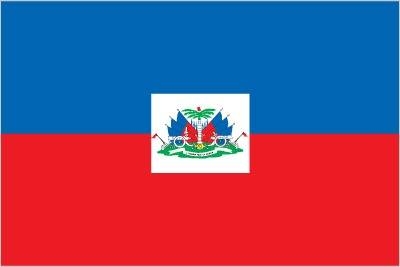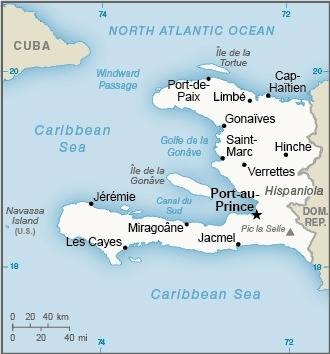Country Summary




Introduction
Background
In 1697, Spain ceded to the French the western third of the island of Hispaniola, which later became Haiti. The French colony, based on forestry and sugar-related industries, became one of the wealthiest in the Caribbean. Currently the poorest country in the Western Hemisphere, Haiti continues to experience bouts of political instability.
Geography
Area
total: 27,750 sq km
land: 27,560 sq km
water: 190 sq km
Climate
tropical; semiarid where mountains in east cut off trade winds
Natural resources
bauxite, copper, calcium carbonate, gold, marble, hydropower, arable land
People and Society
Population
11,334,637 (2022 est.)
Ethnic groups
Black 95%, mixed and White 5%
Languages
French (official), Creole (official)
Religions
Catholic 55%, Protestant 29%, Vodou 2.1%, other 4.6%, none 10% (2018 est.)
Population growth rate
1.2% (2022 est.)
Government
Government type
semi-presidential republic
Capital
name: Port-au-Prince
Executive branch
chief of state: President (vacant); note - Prime Minister Ariel HENRY assumed executive responsibilities, including naming Cabinet members, following the assassination of President MOISE on 7 July 2021; new elections have not yet been scheduled
head of government: Prime Minister Ariel HENRY (since 20 July 2021)
Legislative branch
description: bicameral legislature or le Corps legislatif ou le Parlement consists of:
le Sénat de la République or Senate (30 seats; 10 filled as of March 2022); members directly elected in multi-seat constituencies by absolute majority vote in 2 rounds if needed; members serve 6-year terms (2-term limit) with one-third of the membership renewed every 2 years)
la Chambre des députés or Chamber of Deputies (119 seats; 0 filled as of March 2022; members directly elected in single-seat constituencies by absolute majority vote in 2 rounds if needed; members serve 4-year terms; no term limits); note - when the 2 chambers meet collectively it is known as L'Assemblée nationale or the National Assembly and is convened for specific purposes spelled out in the constitution
Economy
Economic overview
small Caribbean island economy and OECS-member state; extreme poverty; enormous income inequalities; destabilization due to recent presidential assassination; US preferential market access; deteriorating human capital and infrastructure investments
Real GDP (purchasing power parity)
$31.62 billion (2020 est.)
Real GDP per capita
$2,800 (2020 est.)
Agricultural products
sugar cane, cassava, mangoes/guavas, plantains, bananas, yams, avocados, maize, rice, vegetables
Industries
textiles, sugar refining, flour milling, cement, light assembly using imported parts
Exports
$1.73 billion (2019 est.)
Exports - partners
United States 81%, Canada 7% (2019)
Exports - commodities
clothing and apparel, eels, essential oils, perfumes, mangoes, cocoa beans (2019)
Imports
$5.21 billion (2019 est.)
Imports - partners
United States 39%, China 22%, Turkey 5% (2019)
Imports - commodities
refined petroleum, rice, clothing and apparel, palm oil, poultry meats (2019)
Exchange rates
gourdes (HTG) per US dollar -
Page last updated: Monday, August 29, 2022
